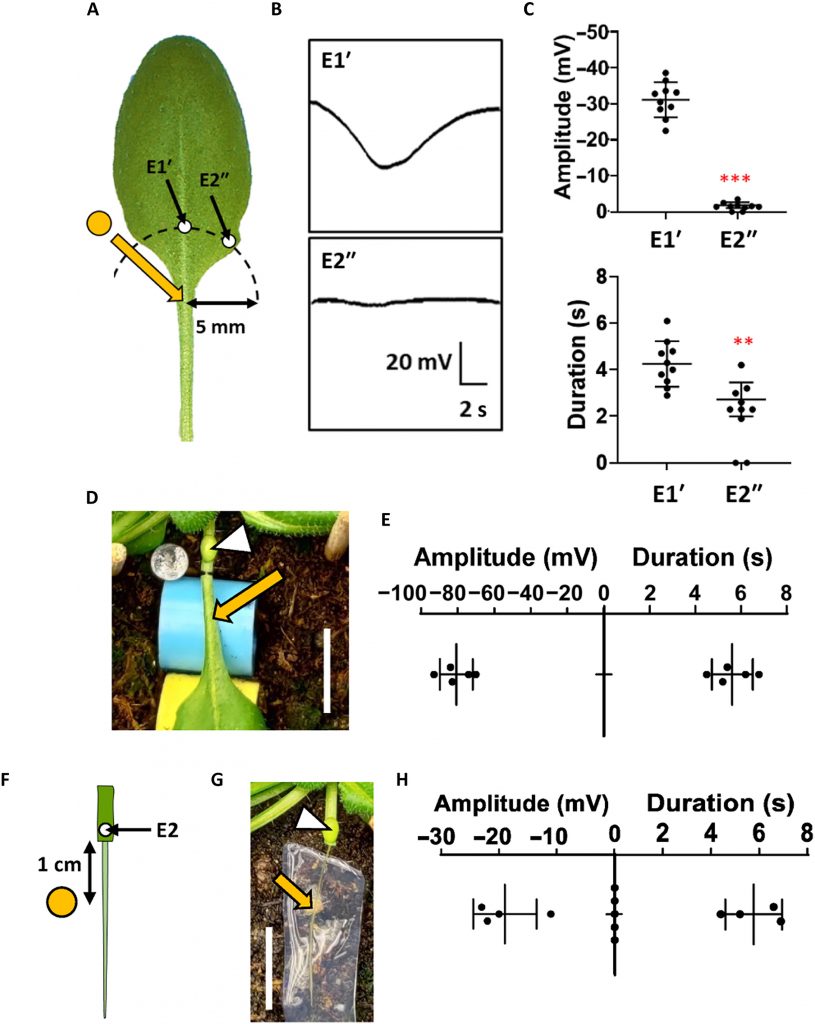Plants are very sensitive to mild mechanical stimulation. For example, stem contact almost immediately blocks phloem carbon translocation in bean (Vicia faba) and cotton (Gossypium hirsutum). These findings highlight the fact that even mild, non-destructive touch stimuli can have rapid effects on fundamental physiological processes of plant growth. Better known is the role of phloem in electrical signaling in insectivorous plants; when insects stimulate trichomes on the leaf epidermis, the plants capture prey. However, it is unclear whether the vascular system of plants has the ability to sense touch.
The study first developed a method to quantitatively measure touch-responsive electrical signals in Arabidopsis leaves and veins. Spherical borosilicate beads were dropped onto 5-week-old rosette leaves, and noninvasive surface electrodes were placed at 0.5 cm intervals along the main veins of the leaves at E1' and E2' above, and at E1 and E2 at the base. The results showed that electrical signals induced in leaves by mechanical stimulation showed strong diurnal regulation. Repeated stimulation at the same site approximately 90 minutes later produced a full-amplitude signal. However, when stimulation is repeated over a shorter time frame, only moderate amplitude signals are produced. Furthermore, electroactivity is independent of trichomes and activates the jasmonic acid (JA) pathway.
The study found that electrical signals generated by mechanical stimulation can be detected distally in the outer vascular tissue; the impact of beads on the main vein induces electrical signals in the distal intact petiole. So, do phloem cells respond to bead stimulation? Using intracellular electrodes, the researchers detected that touch induces membrane depolarization in phloem cells. Although the amplitude of the phloem signal is similar to that of the surface potential, the duration of the phloem signal is significantly shorter than that of the surface potential.

On this basis, this study mutated multiple Arabidopsis H+-ATPase (AHA) genes (AHA1, AHA3, AHA8 and AHA11) expressed in companion cells and found that the aha1 aha3 double mutant could significantly weaken the plant's touch response. Meanwhile, aha1 aha3 plants grow more slowly and is sterile. Using AHA3pro::AHA3-GUS transgenic plants, this study found that AHA3 is expressed in all tertiary veins throughout the leaves.
In summary, this study developed a method to quantify touch-responsive electrical signals in Arabidopsis leaves and leaf veins and found that mechanical stimulation induces diurnal regulated electrical signals in leaves that depolarize the membranes of phloem cells, and that AHAs (especially AHA1 and AHA3) are involved in the electrical signaling induced by mechanical stimulation.
Reference:
Yang, T.H., et al. Mechanosensation in leaf veins. Sci Adv. 2023, 9(38): eadh5078.